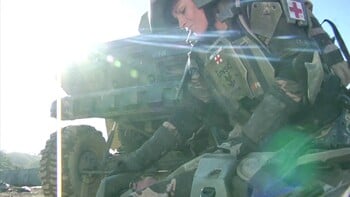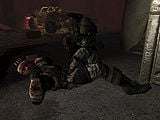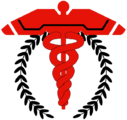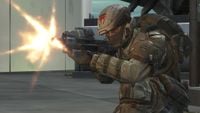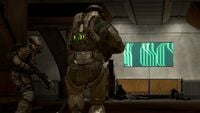Hospital corpsman: Difference between revisions
From Halopedia, the Halo wiki
No edit summary |
m (JackVibe moved page Hospital corpsman to Corpsman: "Hospital corpsman" is copied from the Wikipedia article and the phase is never used in the Halos series.) |
(No difference)
| |
Revision as of 18:23, December 9, 2023
| There is more information available on this subject at Hospital corpsman on the English Wikipedia. |
A hospital corpsman, sometimes known as a combat medic or simply medic,[1][2][Note 1] is a rating within the UNSC Navy.[3]
Overview
Responsibilities
In the UNSC Army, a command team is typically comprised of an officer, a radio operator, and a medic.[4] In the UNSC Marine Corps, corpsmen are assigned to units of various sizes, ranging from smaller units like squads,[1][2] to larger platoons.[5] They treat troops' field injuries in any hostile environments; as such, they are often referred to as "docs".[6] They are also trained for any combat scenario in a light infantry role.[7] Outside of combat, while it is recommended a doctor administers cytoprethaline to personnel before they enter cryo-sleep on starships, medics are often the ones that perform the injections on UNSC personnel.[8]
Equipment
Corpsmen adopt the same Battle Dress Uniform as the UNSC Marines. Corpmen wearing the M52B body armor are either distinguished by a red cross on a white background on their helmets and pauldrons,[9] or adopt dark gray combat utilities with white armor and red details.[10] The post-war Marine BDU use red and white color motifs on body armor to denote medics.[11] Similarly, medical personnel in the UNSC Army wear the same battle dress uniform as UNSC Army troopers, albeit with an asklepian emblem on their helmet and shoulder pads.[7] In more recent years, the SUTURE-class Mjolnir has been approved for testing aboard ANVIL Station—intended for use by SPARTAN-IV combat medics.[12]
Furthermore, medics carry both hard and soft cases that contain numerous medical supplies, including biofoam injection canisters and more direct-application tools for field surgery and dismemberment mitigation. They typically carry short-to-mid range weapons.[7]
Ngoc Benti in a corpsman BDU variant
Gruss in a corpsman ODST armor variant
Known corpsmen
Gameplay
Halo Wars
In Halo Wars, the player can research the "Medics" upgrade at the Barracks for the cost of ![]() 3 and
3 and ![]() 700. It adds a medic to each squad of Marines. He will fight alongside the others with an assault rifle, and when the squad is idle, will automatically begin healing it. While the medic is healing the squad, an Easy difficulty shield will appear over the squad with a green cross over it.
700. It adds a medic to each squad of Marines. He will fight alongside the others with an assault rifle, and when the squad is idle, will automatically begin healing it. While the medic is healing the squad, an Easy difficulty shield will appear over the squad with a green cross over it.
Halo: Reach
UNSC medical personnel make a common appearance in Halo: Reach. These medics, however, fight exactly like normal troopers, and will not aid the player or any allies in gameplay whatsoever.
Production notes
- The UNSC rank structure is largely derived from the system employed by the 21st century United States military, in which a hospital corpsman is an enlisted rating within the navy; naval corpsmen sometimes serve in a US Marine Corps unit, whereas combat medics serve within the US Army instead. In Halo: Contact Harvest, it was established that corpsman are naval personnel; additionally, it was implied that UNSC Navy's corpsmen, while not members of the UNSC Marine Corps, are sometimes attached to UNSC Marine Corps units, like corpsman Healy being assigned to Avery Johnson's First Platoon.[3] However, in Halo 3, Sergeant Major Avery Johnson referred to a corpsman as a Corporal,[13] which is a rank in the Unified Ground Command subordinates (UNSC Army, Air Force, and Marine Corps), but not in the UNSC Navy.[14] Furthermore, the terms "corpsman" and "combat medic" have also been used interchangeably, or medical personnel in the UNSC Marine Corps were called "combat medics". In Halo Wars, marine units are granted the passive ability to heal outside of combat with the "Medic" upgrade, which "adds a combat medic to the squad". In her Halo Wars 2 Phoenix Logs entry, Corpsman Grus was referred to as a "Navy combat medic" rather than a "Navy corpsman".[1] In Halo: The Rubicon Protocol, Lucas Browning identified himself as "Marine Combat Medic",[15] and later, a "combat medic for the UNSC Marine Corps",[16] seemingly implying that the role of a combat medic exists within the UNSC Marine Corps.
- The medic in Halo Wars appears to be holding a battle rifle in the circle menu, though they still use an assault rifle like a standard Marine.
- "Corpsman" appears as a name option for custom Loadouts in Halo: Reach.
Gallery
A corpsman treats a wounded Marine in Halo 3.
The emblem seen on medics and trauma kits in Halo: Reach.
An UNSC Army medic firing an MA37 assault rifle in Halo: Reach.
An UNSC Army medic giving directions to SPARTAN-B312 in Halo: Reach.
Comparison between the post-war armors worn by a marine and a medic in Halo 4.
Concept art for a medic in Halo Infinite.
List of appearances
- Halo: The Fall of Reach (First appearance)
- Halo: The Flood
- Halo: Landfall
- Halo 3
- Halo: Contact Harvest
- Halo Wars
- Halo: Evolutions - Essential Tales of the Halo Universe
- Halo: Reach
- Halo: Last Light (Mentioned only)
- Halo: Ground Command
- Halo Wars 2
- Halo Infinite
- Halo: The Rubicon Protocol
Notes
- ^ The terms "corpsman" and "combat medic" have been conflated throughout the Halo series. See this article's production notes section.
Sources
- ^ a b c Halo Wars 2, Phoenix Logs: Corpsman Gruss
- ^ a b Halo Waypoint, Canon Fodder - Stay Frosty (Retrieved on Jun 17, 2018) [archive]
- ^ a b Halo: Contact Harvest, chapter 4: ""Healy. Petty Officer First Class. Corpsman." All of which meant Healy was navy—not a marine."
- ^ Halo: Ground Command: "A UNSC Coimmand Team is comprised of an Officer, Radio Operator and Medic. The team's presence can improve a unit's ability to react to deadly situations and harden their resolve in the heat of battle."
- ^ Halo: The Flood, chapter 1
- ^ Halo: The Rubicon Protocol, chapter 5
- ^ a b c Halo Encyclopedia (2011 edition), page 56
- ^ Halo Encyclopedia (2011 edition), page 226
- ^ Halo: Landfall - Halo: Last One Standing
- ^ The Mona Lisa: motion comic
- ^ Halo 4: The Essential Visual Guide, page 32
- ^ Halo: The Master Chief Collection, Halo 3 armor customisation: Suture armor description "Spartan combat medics and specialized Mjolnir are a new experiment series approved for ANVIL testing."
- ^ Halo 3, campaign level Arrival
- ^ Halo: Official Spartan Field Manual, page 140
- ^ Halo: The Rubicon Protocol, chapter 3
- ^ Halo: The Rubicon Protocol, chapter 33
